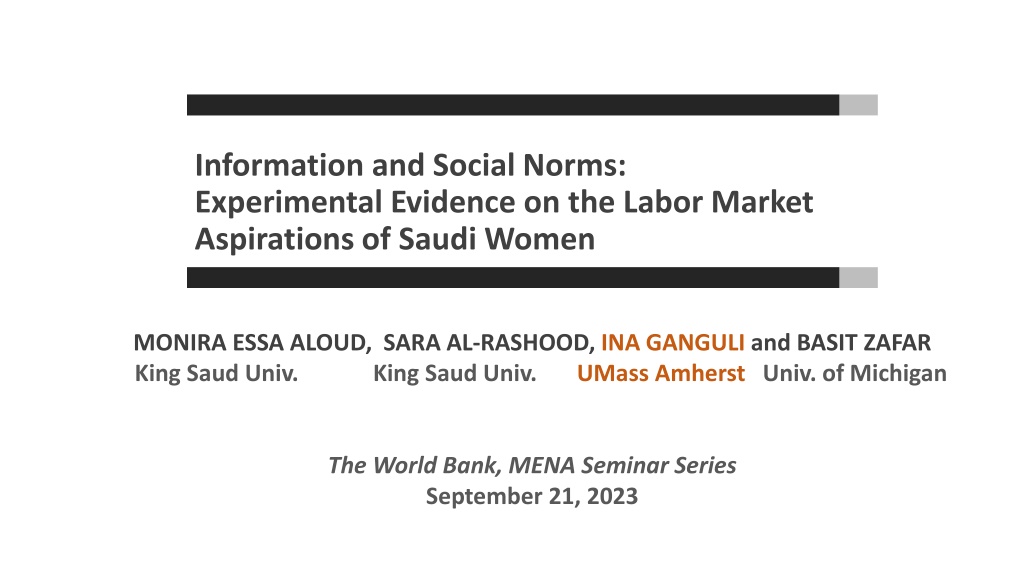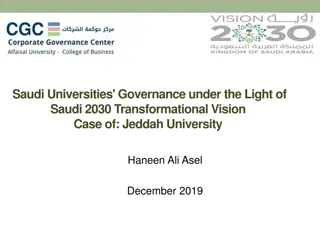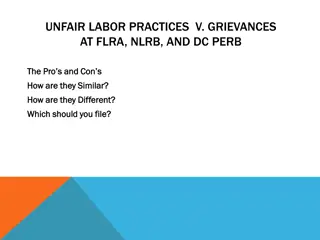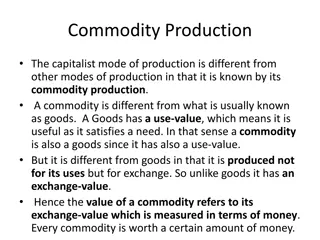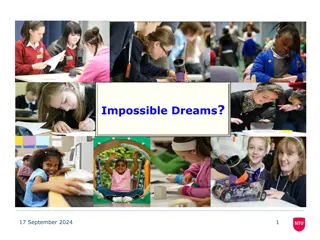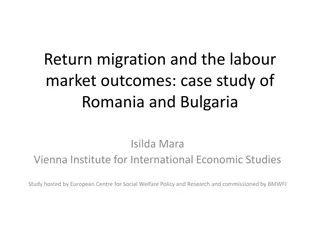Understanding Labor Market Aspirations of Saudi Women
Experimental evidence shows that women in Saudi Arabia face low labor force participation rates due to a lack of information about the job market and societal norms. Providing information on progress could impact women's aspirations, but familial expectations and social norms might still constrain them. A study at King Saud University surveyed female bachelor's students to measure their aspirations, marriage and fertility expectations, and educational experiences, randomizing the provision of labor market and social information to examine its effects.
Download Presentation

Please find below an Image/Link to download the presentation.
The content on the website is provided AS IS for your information and personal use only. It may not be sold, licensed, or shared on other websites without obtaining consent from the author. Download presentation by click this link. If you encounter any issues during the download, it is possible that the publisher has removed the file from their server.
E N D
Presentation Transcript
Information and Social Norms: Experimental Evidence on the Labor Market Aspirations of Saudi Women MONIRA ESSA ALOUD, SARA AL-RASHOOD, INA GANGULI and BASIT ZAFAR King Saud Univ. King Saud Univ. UMass Amherst Univ. of Michigan The World Bank, MENA Seminar Series September 21, 2023
Female Labor Force Participation in Saudi Arabia 1990: 14% 2010: 18% 2018: 23% 27% increase (5-ppt) over less than a decade
Why is Womens Labor Force Participation so low? In a rapidly changing environment, there is good reason to believe that women lack information about the labor market and prevailing social norms (Fernandez, 2013) Biased beliefs incomplete information: - Growing literature showing students and parents are not fully informed about the labor market when making educational choices - Choices can be impacted by the provision of labor market information (e.g. Dizon-Ross, 2018; Wiswall and Zafar, 2015)
Social norms: - Cultural attitudes toward women working may constrain LFP (e.g. Jayachandran, 2019; Miller, Peck and Seflek, 2019; Fernandez and Fogli, 2009) - Women or their families (husbands, parents) may misperceive social norms (Bursztyn et al., 2020) Interaction of information and social norms: - It may be that information will only be effective if there aren t other barriers here, info about the labor market may only impact aspirations if they are consistent with social norms
Could providing information on the pace of progress have an impact on women s labor market aspirations? Or would they still be constrained by their families expectations and prevailing longstanding social norms?
Our study Experiment at King Saud University We conducted a survey of approximately 1,000 female bachelor s students in 2018 at a large public university We measure: - Aspirations prior to entering labor market (supply-side) - Expectations about marriage and fertility - Educational experiences - We randomize: (1) the provision of labor market and social information (2) the same information + prime to make family and social norms more salient
Why Focus on KSU Female Students? KSU is the largest public university in Saudi Arabia One of 2 Saudi universities in the top 150 universities in the Shanghai (AWRU) ranking in 2018
Why Focus on KSU Female Students? Tertiary enrollment has increased from 39% in 2010 to 68% in 2017 Women s employment rates are highest among university graduates These are women most likely to be on margin of deciding whether to enter the labor force in the coming years
Study Design 1. First ask students their perceptions of labor market returns and perceptions of their female peers career and family expectations ( population beliefs) 2. Randomly provide 2 subgroups with: 1. [T1] Social and labor market information (average earnings, unemployment assistance program, aspirations of female peers) 2. [T2] Same plus a prime to make their parents salient ( Would you be interested in having a summary of your answers be shared with your parents? ) 3. Ask students about their own career and family aspirations ( self beliefs) Control group receives same survey apart from stage 2 information
T1: Info about labor market Here is some information about your KSU peers plans: In a survey we conducted earlier this year , female students at KSU reported a very high likelihood, 80%, of working for pay when they are 25 years old. We also found that KSU female students, on average, expect to get married by age 25, and to have their first child by age 28. Here are some statistics about monthly wages. The average monthly wages of Saudi female workers with a college degree in 2017 was 10,072 riyals per month. Here is some information about the Hafiz job assistance program administered by the Human Resources Development Fund (HRDF): The Hafiz Searching for Employment program provides training and motivational services and financial assistance of up to 2,000 SAR monthly in order to support and enable job search among Saudis. Job seekers enrolled in Hafiz gain access to job placement centers, TAQAT- online job postings, Liqaat career fairs, numerous education and training offerings, and many more services. They also receive financial support, provided for a period of 1 year, to ease the financial strain of unemployment and allow them to fully focus on finding work.
T2: Info + parents prime The answers you provide in this section might be helpful for you in discussing your post-college plans and career options with your parents. Would you be interested in having a summary of your answers be shared with your parents? What would be the best way of sharing this information with your parents? Note that the students answers were not actually shared with their parents
Results High labor market aspirations Students have much higher expectations of working than the actual female LFP among older generations Respondents beliefs about themselves are significantly higher than their corresponding population beliefs Self-belief of working at the age of 25 was 67.7% Belief of other KSU students working at age 25 was 54.2%
Population Beliefs All Control T1 T2 pvalue (1) (2) (3) (3) (4) 54.38 54.22 54.44 54.48 0.9833 Belief about % Female Working 47.59 48.04 47.38 47.33 0.8898 Belief % Fem Working FT| Work 27.88 27.97 27.81 27.85 0.9933 Belief about % Females Working FT 6027.13 6098.31 6031.25 5948.75 0.8261 Belief about Monthly Earnings
Self Beliefs All Control T1 T2 pvalue (2) (3) (4) (5) (6) Self Beliefs 69.40*** 67.74*** 70.38*** 70.17*** 0.2746 % Chance of Working at Age 25 64.48*** 60.95*** 64.77*** 67.89*** 0.0027 %Chance of Working FT| Working 47.91*** 43.93*** 49.07*** 50.94*** 0.0049 % Chance of Working Full-Time 8701.13*** 8517.52*** 9005.01*** 8589.52*** 0.3313 Expected Monthly Salary (Riyals)
Experiment Results Information matters Relative to the Control group, expectations about labor force participation are significantly higher in the T1 (info only) group T2 (making parents salient) increases students labor market expectations relative to the Control group Effects are often larger than in T1 (info only) group Cultural norms still matter: T2 leads to an increase in expectation of working in Education and Public sector
Results Information and parents prime effects
Results: Expectations of Working Information and parents prime effects Prob Work FT| Work Prob Work FT (1) (2) 60.95*** (1.40) 3.82** (2.06) 6.94*** (1.97) 43.93*** (1.49) 5.15** (2.20) 7.01*** (2.21) Constant Treatment1 Treatment2 0.13 892 64.48 0.01 0.42 892 47.91 0.01 p-value Observations Mean of Dep var R2
Results: Expectations of Working in Sectors Information and parents prime effects Public Sector Education Health Services (1) (2) (3) (4) 20.34*** (1.24) 1.24 (1.82) 3.96** (1.91) 14.37*** (1.19) 2.19 (1.85) -0.79 (1.72) 3.73*** (0.41) -0.81 (0.54) -1.24** (0.55) 52.77*** (1.28) 3.54* (1.85) 5.13*** (1.86) Constant Treatment1 Treatment2 0.17 966 22.04 0.00 0.11 956 14.82 0.00 0.40 958 3.06 0.01 0.40 965 55.60 0.01 p-value Observations Mean of Dep var R2
Who does it impact most? Students who under-estimate the expectations of their peers are most impacted by the treatment Impacts mainly due to new information about peers aspirations T2 impacts are driven by students who want to share their responses with their parents
Why did T2 have such large effects? Follow-up survey with 150 KSU students Almost all believe their parents expect them to work Many would like the opportunity to discuss their future plans with their parents: 79% would share their responses with parents 71% would share the information with at least one parent Why? inform them about how Saudi society is changing (65%) make them happy to know that more people think like me (29%)
Follow-up survey: Spring 2019, 150 students Inform How Saudi Society is Changing 65% Reasons to/not Share Info: Let Me Work and Delay Marriage 7% Inform Them Others are Like Me 29% Not Share: Upset/Disappoint Them 7% Make Parents Happy 39% Reactions to Share Info: Make Parents Disappointed 5% No Change 34% Not Sure 23%
Summary of key results Students have much higher expectations of working than the actual female LFP among older generations Receiving information about peers aspirations leads to higher expectations of working Making parents salient also increases students labor market expectations, likely because they think their parents want them to work But norms still matter: making parents salient leads to higher expectations of working in education and the public sector - sectors that are more culturally accepted for women. Most students would like to discuss their future plans and the information with their parents
Future Research Questions More research is needed to understand: 1) The preferences and beliefs of parents regarding their children s future plans 2) The process of decision-making between the students and their parents 3) If these effects would be different in a broader sample of youth (our results are from a college-going sample) 4) The link between expectations and behavior we show that information impacts aspirations. To what extent actual behavior is impacted is unclear (and requires long-term panel studies).
